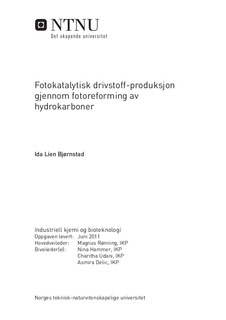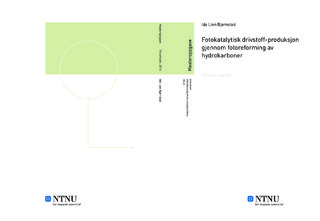| dc.description.abstract | The purpose of this study is to investigate the photoreforming of methanol for hydrogen production. Since the photocatalysis field needs a cheaper efficient photocatalyst than the more common Pt loaded TiO2, CuO loaded TiO2 was the chosen photocatalyst in this study.
This study investigated the impact of preparation methods on the photocatalysts. Incipient wetness impregnation, deposition precipitation and sol-gel preparation was studied. The impact of CuO loading, surface area and the phase content of TiO2 on photoactivity were also supposed to be investigated.
The prepared photocatalysts were characterized with temperature programmed oxidation and reduction, X-Ray Diffraction, UV/vis spectrophotometry, SEM, EDS, BET surface area measurements and chemisorption measurements.
The incipient wetness impregnation (IWI) preparation decreased the surface area of the photocatalyst more than the deposition precipitation (DP) preparation, since the CuO particles deposited more in the pores with the IWI method. The DP prepared photocatalyst was more easily reduced and contained lower amount of amorphous phase in the photocatalyst than IWI photocatalysts.
The results from the UV/vis spectrophotometry showed the band gap of the photocatalyst decreased with increasing CuO loading, and that pure P25 had slightly higher band gap than anatase. There was not found any band gap dependency on surface area or crystallite size. The XRD results showed CuO dispersion increased with increasing surface area, and P25 contains more amorphous phase than the anatase and rutile photocatalysts.
The photoactivity measurements showed photocatalytic hydrogen evolution, but the evolution rate was too low for calculations. An improvement in the photoreforming setup is required for a proper investigation of the photocatalytic activity of the photocatalysts. Activity measurements should be conducted to find which parameters affect the photoactivity and which preparation method gives the most active photocatalysts. | |

